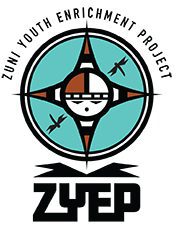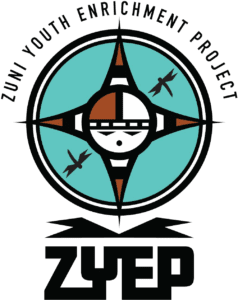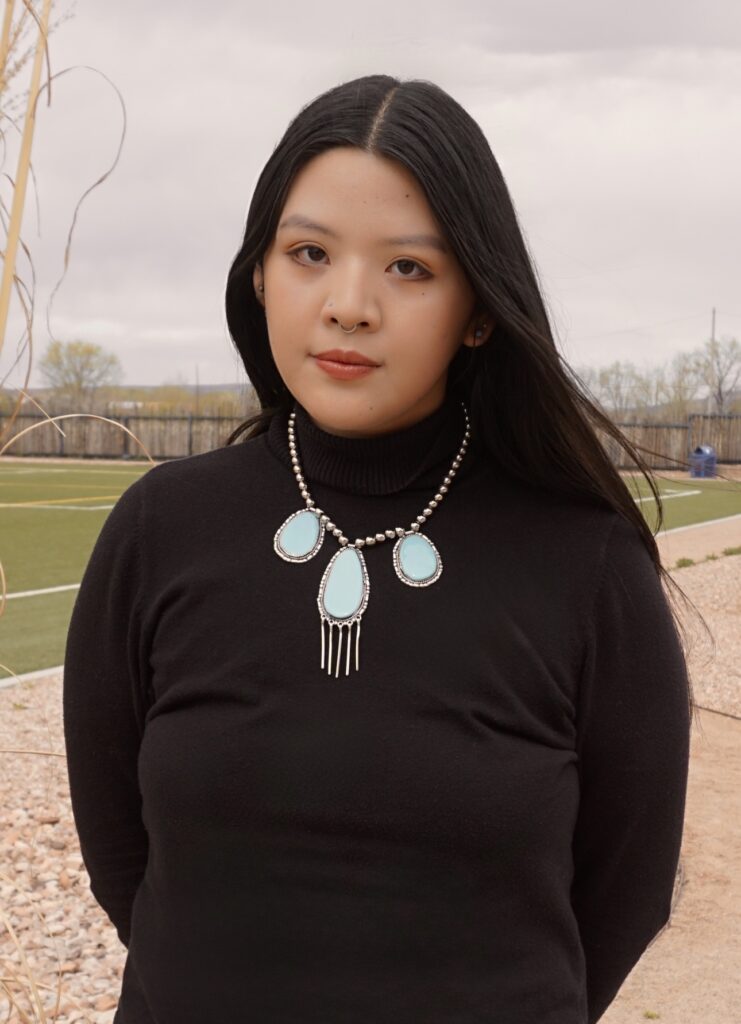When Mia Sutanto moved from suburban Chicago to the Pueblo of Zuni at age 14, she felt like she’d landed in another world. Years later, that move—and a flyer she happened to notice at a local grocery store—would set her on a path toward an artistic career and finding her own unique voice.
Mia was born in Downers Grove, Illinois, to a father from Indonesia and a mother from Zuni. She grew up in nearby Naperville, a western Chicago suburb with a population of roughly 150,000. She says the move to Zuni during her freshman year of high school felt like a real shock.
“I spent time on the rez every summer, visiting my grandma, but never for more than two weeks at a time,” she says. “Zuni is a small community. I wasn’t used to driving hours to get to a larger town, and it was hard to connect to other kids at first, because they’d known each other all their lives.
“It also surprised me to see so many people who looked like me. I was the only Native for miles in Illinois!”
Mia began her freshman year in Naperville but finished it at Zuni High School, where she spent her sophomore year as well. Then she shifted to Middle College High School in Gallup, graduating in 2018.
During her two upperclass years at the public charter school, Mia says she didn’t have the capacity to take on extracurricular activities. Her college-level schoolwork and the twice-daily commute between Zuni and Gallup took almost all of her time, and any free time left over was spent in the library.
“My plan was to be pre-med, so I was taking a lot of science classes and labs,” she says. “After I graduated, I went to Fort Lewis College in Durango, Colorado. My brother went there, plus they offered free tuition to Native students.”
Mia embarked on an English major with additional coursework in chemistry, but she says she struggled to find her place and experienced burnout, which worried her. After the first semester, she returned home to Zuni to focus on her health.
A couple of years later, Mia began taking online classes through the University of New Mexico in Albuquerque. She enjoyed it, so in 2021, she moved to the main campus, though she continued her coursework online.
“It wasn’t a great fit,” she says, “and I moved back home.”
To support her well-being while in Albuquerque, Mia turned to art. She says her earliest childhood memories involve drawing while sprawled out on the floor.
“My mom would come home from work, and I would draw and talk to her while she made dinner,” Mia recalls. “She would take us to the library every weekend, too, and I would find books on history and art that I loved. I got bored in the kid section!”
Through the years, art proved to be a valuable way for Mia to relax, ease her mind, and simply be with herself. And, as childhood gave way to young adulthood, her sketching also evolved.
“I designed T-shirts and logos, and I developed an idea for a clothing brand,” she explains. “I thought maybe I could continue working on my art during my break in Zuni, while I figured out where to go from there.”
Fate intervened when Mia’s doctor recommended a book called “The Artist’s Way” by Julia Cameron, a book is filled with creative exercises such as “artist dates.” Mia embraced the idea and chose to start taking walks in her community.
One day in early 2022, as she walked to Halona Marketplace, she saw a flyer for the Zuni Youth Enrichment Project’s new Emerging Artist Apprenticeship program. This first cohort would focus on two-dimensional art and graphic design, a perfect fit at the perfect time for Mia.
“I thought, wow, I can get paid to learn, and I don’t have to leave town to do it,” she marvels. “I was excited about the opportunity, because I didn’t have the right tools to do what I wanted to do, and the guidance on YouTube felt overwhelming and involved a lot of upselling.”
During her six-week apprenticeship, Mia learned how to use different digital tools, and how designs enhance different products. She also valued learning more about Zuni culture.
“My mom grew up in the Mormon Church,” she explains. “Zuni culture is deeply connected to religious practices, and I didn’t know a lot. During the apprenticeship, I could ask questions, and the art leaders educated us and provided resources.
“I also learned a lot from the other students and their stories, which helped me feel more connected to my community.”
As one of the top three students from her apprenticeship cohort, Mia participated in the Bernalillo Indian Arts Festival in Bernalillo, New Mexico, in May 2022. She was nervous, and she said the group had to hustle to be ready for their first regional art show.
“It was such a good experience,” she remembers. “I made a lot of sales, which boosted my confidence, and I talked with a lot of people. The best way to deal with social anxiety is to connect with someone. People value getting to know the artist and know the story behind the artwork.
“I enjoyed seeing people connecting to the art, too,” she added. “It makes the pieces feel alive and ignites their purpose.”
Mia went on to participate in ZYEP’s intensive Advanced Artist Apprenticeship that fall. From October through March 2023, she and her two fellow advanced apprentices focused on the business aspect of their art and how to build viable careers.
During the advanced apprenticeship, Mia showcased her work in Phoenix, Arizona, where she also enjoyed a visit to the Heard Museum, which is dedicated to the advancement of Native art. These experiences showed Mia that she could not only create and sell her artwork, but she also could travel—something she’d always longed to do.
“It really opened my eyes, that I don’t have to just make do,” she says. “These are the opportunities art provides.”
This October, her art journey took her to Seattle with ZYEP staff and fellow advanced apprentices Cassandra Tsalate and Gregory Baca III. Their five-day trip immersed them in Indigenous art, culture, and advocacy beyond the Southwest, also providing a new perspective on their work, their identities, and their place in a broader national conversation about Native visibility and resilience.
For Mia, it was exciting to experience the Indigenous art scene in an urban environment, and know how important Indigenous art is—in all its forms and expressions. She says she felt a sense of real freedom that touched her deeply.
“I wish the kids here could see and feel that, and know that they are enough,” she says softly. “Their art is Indigenous because they made it. It doesn’t have to check a box.”
Mia’s own artistic inspirations and interests are wide-ranging, and she is fascinated by the intersection between culture, art, and advocacy. She says she is drawn to Basquiat, a self-taught artist who became famous in the 1980s neo-expressionism movement.
“I’m interested in his activism, his intention with his work, and the way the art world reacted to him,” she says. “He got bashed a lot, and people minimized his work. But he went to his roots and brought that forward with a real focus on identity and history, which isn’t always pretty.”
She also is interested in art nouveau, and early East Asian art. She appreciates 1930s matchboxes, reads and writes poetry, and is an ardent Shakespeare fan.
“His work has a strong advocacy component,” she says.
Today, Mia is a working artist. She started her business with proceeds from her apprenticeships and early art shows, investing funds in tools like an iPad and Apple Pencil. And, she learned how to chart her own course instead of falling victim to the ever-changing winds of public opinion.
“I was burning out early on, trying to figure out how to make what would sell,” she explains. “I had a lot of sleepless nights. I had to learn to take advantage of opportunities but to do it in a healthy, sustainable way—and make what I am interested in.”
She and her partner, Breydon, also an independent artist, invested in their own equipment and created their own private workspace. They focus on local shows first and raise the funds they need to travel to out-of-state shows in places like Arizona and California.
They also sell through the Ancestral Rich Treasures of Zuni (ARTZ) Cooperative gallery, where Breydon is vice president at the moment, and through social media. Mia can be found on Instagram @poserpasta, and she is currently in the process of building her own website and online shop.
In a recent highlight, the owner of Bidii Baby Foods, a Navajo-owned Indigenous baby food line, saw a piece Mia created that depicted an Edward Scissorhands-inspired figure with Zuni regalia and corn hands. He bought it—and dressed up as that figure for Halloween.
“That was a big one for me,” Mia says, smiling. “I also recently completed my first commissioned work a couple of weeks ago. I was terrified at first, but it went well!”
As Mia looks back on her journey, she says she is grateful that she trusted her own intuition—and that she took a chance when she saw that ZYEP flyer.
“I left college because I had to,” she says. “I went with my gut, because art made me feel healthy and grounded. And ZYEP offered an accessible program that allowed me to learn and grow.”
That accessibility is critical in Zuni, she says. Anyone can apply, it’s within walking distance for many students, and the staff is welcoming.
“They know your name, and their priority is to make you feel safe and comfortable,” she says. “They encourage you, share opportunities, offer cultural knowledge, and truly value the arts. It’s incredible what they’re able to do. They’re building hope for the future.”
Mia also appreciates that the staff stay in touch with apprentices after their programs have concluded.
“We’ve created our own community,” she says. “It’s like a family, and it really opened up my life.”


